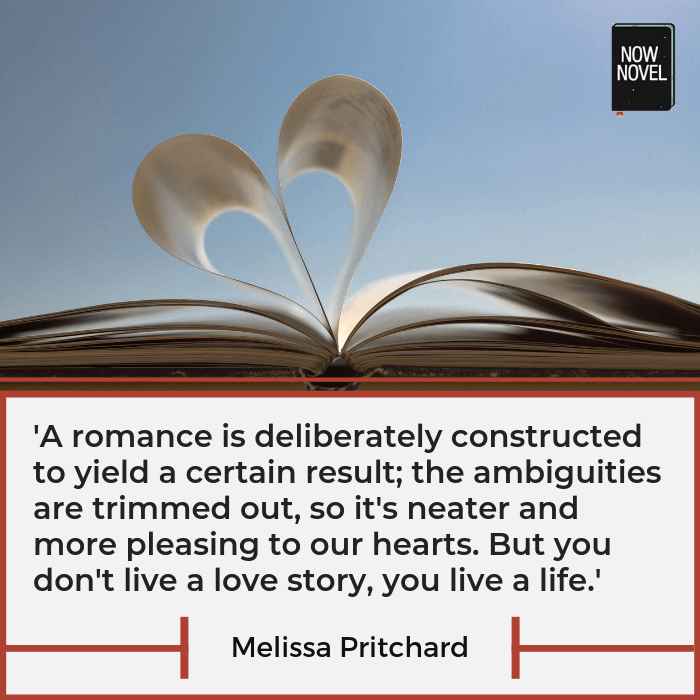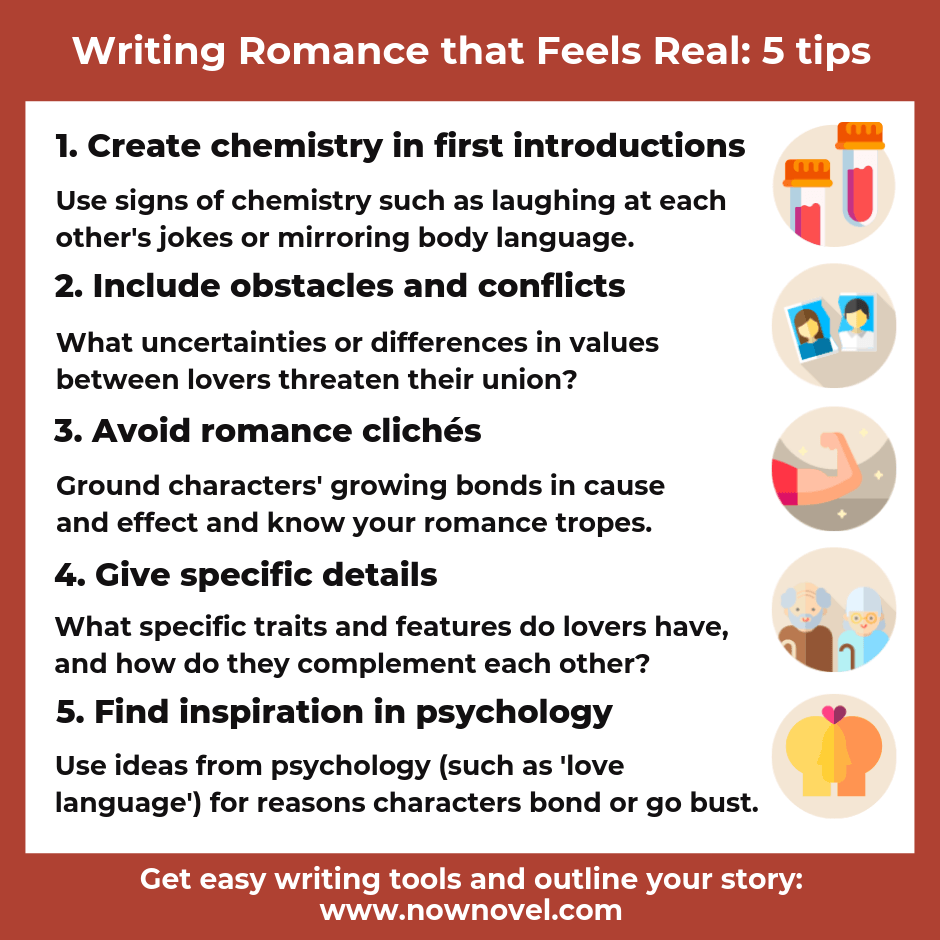Learning how to write romance that feels real is important if you want readers to believe your love story. Read the following tips on how to write chemistry, compatibility, complexity and other key elements of real relationships:
1. Add chemistry to first encounters
There are countless ways to have future lovers meet in a romance story.
Reasons for your characters’ first encounter may run from the mundane (matching on a dating app) to the surprising. For example, a fated-seeming event such as being randomly assigned neighbouring seats on both legs of an international flight.
For a relationship to form, there needs to be an element of chemistry and intrigue. Things that make us curious about others include:
- Mystery: (E.g. not knowing how much the other person likes you)
- Humour: (Supposedly women like men who are funny and men like women who laugh at their jokes – this doesn’t account for non-binary or non-hetero attraction)
- Similarities and coincidences: Shared values and interests give a common ground, and coincidental discoveries (such as having attended the same junior school) can forge a ‘this was meant to be’ feeling
When people appear happy and comfortable in each other’s presence, laugh at each other’s jokes, or mirror each other’s body language from time to time, these are all signs of probable chemistry.
[Brainstorm the Central Idea for characters’ first encounter and create vivid character profiles in our story outlining tool.]
2. Avoid the ‘happy people in happy land’ effect
When attraction and desire are mutual, it’s a fantastic feeling. When we’re writing romance, we might focus on this rose-tinted aspect. It’s easy to forget, though, that the course of a relationship isn’t always smooth, as Psychology Today reminds us here.
Attraction may be instant in some cases. Yet there will also be likely misunderstandings, peaks and valleys, in the course of growing connection. Including obstacles and misunderstandings helps to avoid the phony ‘happy people in happy land’ effect.
First encounters between future lovers don’t need to be positive always. In Jane Austen’s classic novel Pride and Prejudice, for example, Lizzie’s eventual lover Mr. Darcy comes across as cold and superior when she first meets him at a dance. She overhears Darcy being dismissive about the idea of dancing with her.
Anger, hurt and dislike are engaged emotions (unlike indifference). Lizzie still is curious about Darcy, and the reasons for his contemptuous attitude. This curiosity paves the way for future interactions. It sets up the subsequent shift in how Lizzie sees Darcy, as more character complexity (and his noble side) emerges in later exchanges.

3. Avoid romance clichés
Learning how to write romance that feels real means avoiding groan-inducing romance tropes and clichés. These run the risk of making the relationships in your novel not seem earned or believable. TV Tropes lists several romance novel tropes, including:
- Oil-sheikh romantic heroes (‘So popular as the male lead that you can buy ‘sheikh’ omnibuses.’)
- Arranged marriage: (‘A common technique in historicals to force the hero and heroine to deal with each other.’ Arranged marriages in real life usually have a very specific cultural context and aren’t always necessarily romantic)
- He-man woman haters: (‘In which the male hero only hates women because of the actions of a bad woman, and will be cured in the end by the good heroine.’)
The three examples of romance tropes above suggest some of the issues with using clichés in romantic stories.
Stereotypes combining wealth and an exotic otherness (for western readers) may read as two-dimensional or racist at worst, fetishizing at best.
An arranged marriage may seem culturally unlikely to readers, depending on your characters’ context. Or it may read as a rush-job to hurry them into bed.
You could have a situation in your story like the third example (a male character who is misogynistic because he was hurt in a prior relationship).
Yet if the man has to work to resolve his own trauma (and not only be miraculously ‘cured’ by a ‘good’ woman) this may read as more believable. Because there is character development and growth showing the male lead’s evolution, too. Rather than the author merely reproducing simplistic or conservative notions of what a ‘good’ or ‘bad’ woman is or does.
4. Give your characters’ relationship specific details
Sometimes the stereotyped elements are what attract people to each other (such as bulging muscles for men, vivacious curves for women). A lot of what details you use to signal characters’ mutual attraction depends on genre, too (readers may expect archetypal masculinity or femininity in, for example, a category romance).
Yet attraction that grows over time and isn’t only based on physical (or gender) generalities but specific details may read as more real.
For example, characters may be attracted to specifics such as:
- The particular sound of another’s laugh
- Specific, identifying physical traits that are non-general (e.g. an unexpected beauty mark, tattoo, or other distinctive feature)
- A particular sense of humour, quirk or habit
There’s a beautiful example of this in the French-language romantic movie Amelie by Jean-Pierre Jeunet:
Example of specific details in character relationships: Amelie
Near the start of the movie, the narrator introduces Amelie’s parents, describing what they enjoy and dislike as a video montage of these activities plays. Her father loves peeling large strips of wallpaper, for example, while her mother hates having her hand touched by strangers accidentally and pillow marks on her face in the morning.
The one similarity is their love of order and organisation. Each parent’s description ends with how they love emptying out their toolbox (the father) or purse (the mother), cleaning it out, and putting everything back.
These small specifics suggest the ways people’s loves and dislikes intersect. While people’s dislikes and loves may differ, there are also small (and specific) points of common ground that help to explain attraction.

5. Find inspiration for romantic dynamics in psychology
Psychology gives us many concepts and models for writing romance. There are many different theories of compatibility, for example from astrology to the concept of the ‘five love languages’.
Example of using psychological concepts to make a romance writing feel real
In his 1992 book The Five Love Languages: How to Express Heartfelt Commitment to Your Mate, Gary Chapman suggests there are 5 core ways to express our affection to a romantic partner:
- Words of affirmation: Saying kind or appreciative things that build the other person’s sense of our appreciation.
- Gifts: Giving items that show we were thinking of the other.
- Acts of service: Deeds such as cooking a meal that the other would find useful or thoughtful.
- Physical touch: Holding hands, making out – all forms of physical intimacy
- Quality time: Spending time together with undivided attention.
This framework may seem simple to describe the kinds of gestures character value in their romantic partnerships. Yet they can give us plenty of ideas for moments that develop characters’ bonds, as well as potential sources of conflict (when our dominant ‘love languages’ differ).
For example, a scene where two future lovers with shared interests buy each other the exact same gift without realizing could be both sweet and comical.
As for potential conflict, one character might favour ‘words of affirmation’. Because they’re a verbal person. Yet the other may prefer non-verbal signs of affection. They may find their verbal lover’s phrases ‘cheesy’ and respond critically.
Simple ideas such as these from ‘pop’ psychology may thus inspire broad character dynamics as well as individual story incidents.
Get helpful feedback on your characters’ romantic scenes and tools to finish writing your story.
Read this review of Now Novel coach Romy Sommer’s 2023 novel, My Fake Italian Marriage, and an interview with Romy about its genesis.

